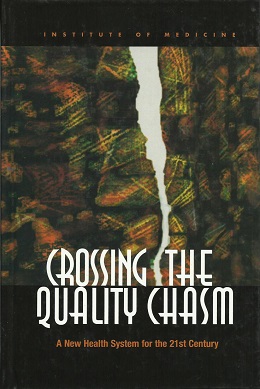Crossing the Quality Chasm
A report by the Institute of Medicine on healthcare quality improvement
Crossing the Quality Chasm: A New Health System for the 21st Century is a landmark report published by the Institute of Medicine (IOM) in 2001. The report addresses the significant gap between the healthcare that people receive and the healthcare that could be provided based on current knowledge. It builds on the findings of the earlier report, To Err is Human, and provides a comprehensive strategy for improving the quality of healthcare in the United States.
Background[edit | edit source]
The report was developed in response to growing concerns about the quality of healthcare in the United States. Despite advances in medical science and technology, the healthcare system was failing to deliver consistent, high-quality care to all patients. The IOM convened a committee of experts to examine the issues and propose solutions.
Key Concepts[edit | edit source]
Six Aims for Improvement[edit | edit source]
The report outlines six aims for a high-quality healthcare system:
- Safe: Avoiding harm to patients from the care that is intended to help them.
- Effective: Providing services based on scientific knowledge to all who could benefit, and refraining from providing services to those not likely to benefit.
- Patient-centered: Providing care that is respectful of and responsive to individual patient preferences, needs, and values.
- Timely: Reducing waits and sometimes harmful delays for both those who receive and those who give care.
- Efficient: Avoiding waste, including waste of equipment, supplies, ideas, and energy.
- Equitable: Providing care that does not vary in quality because of personal characteristics such as gender, ethnicity, geographic location, and socioeconomic status.
Ten Rules for Redesign[edit | edit source]
The report proposes ten rules to guide the redesign of the healthcare system:
1. Care is based on continuous healing relationships. 2. Care is customized according to patient needs and values. 3. The patient is the source of control. 4. Knowledge is shared and information flows freely. 5. Decision making is evidence-based. 6. Safety is a system property. 7. Transparency is necessary. 8. Needs are anticipated. 9. Waste is continuously decreased. 10. Cooperation among clinicians is a priority.
Strategies for Improvement[edit | edit source]
The report emphasizes the need for a comprehensive strategy to improve healthcare quality, which includes:
- Developing new delivery models that focus on patient-centered care.
- Implementing information technology systems to improve communication and coordination.
- Establishing performance measurement and reporting systems to ensure accountability.
- Investing in workforce training and development to equip healthcare professionals with the skills needed for a modern healthcare system.
Impact[edit | edit source]
Since its publication, "Crossing the Quality Chasm" has had a profound impact on healthcare policy and practice. It has influenced numerous initiatives aimed at improving healthcare quality, including the development of Accountable Care Organizations and the implementation of Electronic Health Records. The report continues to serve as a foundational document for efforts to transform the healthcare system.
Related pages[edit | edit source]
Search WikiMD
Ad.Tired of being Overweight? Try W8MD's physician weight loss program.
Semaglutide (Ozempic / Wegovy and Tirzepatide (Mounjaro / Zepbound) available.
Advertise on WikiMD
|
WikiMD's Wellness Encyclopedia |
| Let Food Be Thy Medicine Medicine Thy Food - Hippocrates |
Translate this page: - East Asian
中文,
日本,
한국어,
South Asian
हिन्दी,
தமிழ்,
తెలుగు,
Urdu,
ಕನ್ನಡ,
Southeast Asian
Indonesian,
Vietnamese,
Thai,
မြန်မာဘာသာ,
বাংলা
European
español,
Deutsch,
français,
Greek,
português do Brasil,
polski,
română,
русский,
Nederlands,
norsk,
svenska,
suomi,
Italian
Middle Eastern & African
عربى,
Turkish,
Persian,
Hebrew,
Afrikaans,
isiZulu,
Kiswahili,
Other
Bulgarian,
Hungarian,
Czech,
Swedish,
മലയാളം,
मराठी,
ਪੰਜਾਬੀ,
ગુજરાતી,
Portuguese,
Ukrainian
Medical Disclaimer: WikiMD is not a substitute for professional medical advice. The information on WikiMD is provided as an information resource only, may be incorrect, outdated or misleading, and is not to be used or relied on for any diagnostic or treatment purposes. Please consult your health care provider before making any healthcare decisions or for guidance about a specific medical condition. WikiMD expressly disclaims responsibility, and shall have no liability, for any damages, loss, injury, or liability whatsoever suffered as a result of your reliance on the information contained in this site. By visiting this site you agree to the foregoing terms and conditions, which may from time to time be changed or supplemented by WikiMD. If you do not agree to the foregoing terms and conditions, you should not enter or use this site. See full disclaimer.
Credits:Most images are courtesy of Wikimedia commons, and templates, categories Wikipedia, licensed under CC BY SA or similar.
Contributors: Prab R. Tumpati, MD

